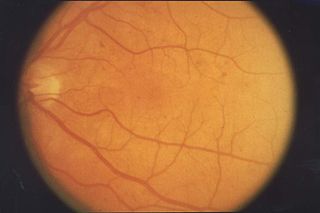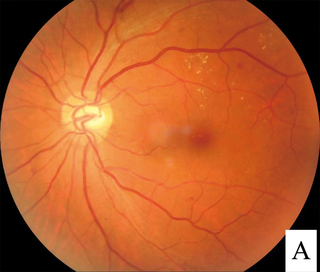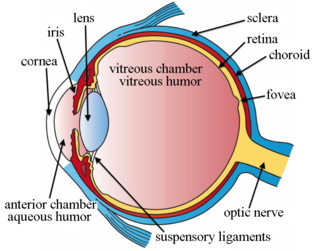Related Research Articles

Ophthalmology is a clinical and surgical specialty within medicine that deals with the diagnosis and treatment of eye disorders. A former term is oculism.

Retinopathy is any damage to the retina of the eyes, which may cause vision impairment. Retinopathy often refers to retinal vascular disease, or damage to the retina caused by abnormal blood flow. Age-related macular degeneration is technically included under the umbrella term retinopathy but is often discussed as a separate entity. Retinopathy, or retinal vascular disease, can be broadly categorized into proliferative and non-proliferative types. Frequently, retinopathy is an ocular manifestation of systemic disease as seen in diabetes or hypertension. Diabetes is the most common cause of retinopathy in the U.S. as of 2008. Diabetic retinopathy is the leading cause of blindness in working-aged people. It accounts for about 5% of blindness worldwide and is designated a priority eye disease by the World Health Organization.

Diabetic retinopathy, is a medical condition in which damage occurs to the retina due to diabetes. It is a leading cause of blindness in developed countries.

Glaucoma is a group of eye diseases that lead to damage of the optic nerve, which transmits visual information from the eye to the brain. Glaucoma may cause vision loss if left untreated. It has been called the "silent thief of sight" because the loss of vision usually occurs slowly over a long period of time. A major risk factor for glaucoma is increased pressure within the eye, known as intraocular pressure (IOP). It is associated with old age, a family history of glaucoma, and certain medical conditions or medications. The word glaucoma comes from the Ancient Greek word γλαυκός, meaning 'gleaming, blue-green, gray'.

Eye surgery, also known as ophthalmic surgery or ocular surgery, is surgery performed on the eye or its adnexa. Eye surgery is part of ophthalmology and is performed by an ophthalmologist or eye surgeon. The eye is a fragile organ, and requires due care before, during, and after a surgical procedure to minimize or prevent further damage. An eye surgeon is responsible for selecting the appropriate surgical procedure for the patient, and for taking the necessary safety precautions. Mentions of eye surgery can be found in several ancient texts dating back as early as 1800 BC, with cataract treatment starting in the fifth century BC. It continues to be a widely practiced class of surgery, with various techniques having been developed for treating eye problems.

Latanoprost, sold under the brand name Xalatan among others, is a medication used to treat increased pressure inside the eye. This includes ocular hypertension and open-angle glaucoma. Latanaprost is applied as eye drops to the eyes. Onset of effects is usually within four hours, and they last for up to a day.
Neovascularization is the natural formation of new blood vessels, usually in the form of functional microvascular networks, capable of perfusion by red blood cells, that form to serve as collateral circulation in response to local poor perfusion or ischemia.

Intravitreal is a route of administration of a drug, or other substance, in which the substance is delivered into the vitreous humor of the eye. "Intravitreal" literally means "inside an eye". Intravitreal injections were first introduced in 1911 when Ohm gave an injection of air into the vitreous humor to repair a detached retina. In the mid-1940s, intravitreal injections became a standard way to administer drugs to treat endophthalmitis and cytomegalovirus retinitis.
Ocular ischemic syndrome is the constellation of ocular signs and symptoms secondary to severe, chronic arterial hypoperfusion to the eye. Amaurosis fugax is a form of acute vision loss caused by reduced blood flow to the eye; it may be a warning sign of an impending stroke, as both stroke and retinal artery occlusion can be caused by thromboembolism due to atherosclerosis elsewhere in the body. Consequently, those with transient blurring of vision are advised to urgently seek medical attention for a thorough evaluation of the carotid artery. Anterior segment ischemic syndrome is a similar ischemic condition of anterior segment usually seen in post-surgical cases. Retinal artery occlusion leads to rapid death of retinal cells, thereby resulting in severe loss of vision.
The blood–retinal barrier, or the BRB, is part of the blood–ocular barrier that consists of cells that are joined tightly together to prevent certain substances from entering the tissue of the retina. It consists of non-fenestrated capillaries of the retinal circulation and tight-junctions between retinal epithelial cells preventing passage of large molecules from choriocapillaris into the retina.

Fundus photography involves photographing the rear of an eye, also known as the fundus. Specialized fundus cameras consisting of an intricate microscope attached to a flash enabled camera are used in fundus photography. The main structures that can be visualized on a fundus photo are the central and peripheral retina, optic disc and macula. Fundus photography can be performed with colored filters, or with specialized dyes including fluorescein and indocyanine green.

Blurred vision is an ocular symptom where vision becomes less precise and there is added difficulty to resolve fine details.

Intraocular hemorrhage is bleeding inside the eye. Bleeding can occur from any structure of the eye where there is vasculature or blood flow, including the anterior chamber, vitreous cavity, retina, choroid, suprachoroidal space, or optic disc.
Sohan Singh Hayreh was an ophthalmologist, clinical scientist, and professor emeritus of ophthalmology at the University of Iowa. As one of the pioneers in the field of fluorescein angiography, he was generally acknowledged to be a leading authority in vascular diseases of the eye and the optic nerve. For over 60 years, Hayreh was actively involved in basic, experimental, and clinical research in ophthalmology, publishing over 400 original peer-reviewed articles in various international ophthalmic journals, six classical monographs and books in his field of research, and more than 50 chapters in ophthalmic books. He made many seminal observations dealing with the ocular circulation in health and disease, the optic disc and the optic nerve, retinal and choroidal vascular disorders, glaucomatous optic neuropathy, fundus changes in malignant arterial hypertension, ocular neovascularization, rheumatologic disorders of the eye, and nocturnal arterial hypotension. He was an elected fellow of the National Academy of Medical Sciences.
The Vision Institute is a research center in the Quinze-Vingts National Eye Hospital in Paris, France. It is one of several such centers in Europe on eye diseases.
Flammer syndrome is a described clinical entity comprising a complex of clinical features caused mainly by dysregulation of the blood supply. It was previously known as vascular dysregulation. It can manifest in many symptoms, such as cold hands and feet, and is often associated with low blood pressure. In certain cases it is associated with or predisposes to the development of diseases such as a normal tension glaucoma. Flammer syndrome is named after the Swiss ophthalmologist Josef Flammer.

Josef Flammer is a Swiss ophthalmologist and long-time director of the Eye Clinic at Basel University Hospital. Flammer is a glaucoma specialist who developed a new pathogenetic concept of glaucomatous damage according to which unstable blood supply leads to oxidative stress, which in turn plays a major role in apoptosis of cells in the optic nerve and retina in glaucoma patients.
The Legacy Devers Eye Institute in Portland, Oregon, is one of the few private, non-profit centers for ophthalmological care, research, and training in the United States. The institute is affiliated with Legacy Health, a network of seven hospitals in Portland and Southwest Washington. Legacy Devers includes the Thelma and Gilbert Schnitzer Comprehensive Glaucoma Center.
Michael Belkin is an Israeli academic and researcher working in ophthalmology, Professor Emeritus of Ophthalmology at Tel Aviv University. His research brought about advances in glaucoma treatment such as the ExPress glaucoma implant, the Ioptimate CO2 laser glaucoma surgery and a fast, non-contact glaucoma laser treatment.

Secondary glaucoma is a collection of progressive optic nerve disorders associated with a rise in intraocular pressure (IOP) which results in the loss of vision. In clinical settings, it is defined as the occurrence of IOP above 21 mmHg requiring the prescription of IOP-managing drugs. It can be broadly divided into two subtypes: secondary open-angle glaucoma and secondary angle-closure glaucoma, depending on the closure of the angle between the cornea and the iris. Principal causes of secondary glaucoma include optic nerve trauma or damage, eye disease, surgery, neovascularization, tumours and use of steroid and sulfa drugs. Risk factors for secondary glaucoma include uveitis, cataract surgery and also intraocular tumours. Common treatments are designed according to the type and the underlying causative condition, in addition to the consequent rise in IOP. These include drug therapy, the use of miotics, surgery or laser therapy.
References
- 1 2 Guidoboni, Giovanna; Chong, Rachel Shujuan; Marazzi, Nicholas; Chee, Miao Li; Wellington, Jessica; Lichtenegger, Emily; Cheng, Ching-Yu; Harris, Alon (2020-06-10). "A mechanism-driven algorithm for Artificial Intelligence in ophthalmology: understanding glaucoma risk factors in the Singapore Eye Diseases Study". Investigative Ophthalmology & Visual Science. 61 (7): 619. ISSN 1552-5783. Archived from the original on 2020-06-20. Retrieved 2021-04-05.
- ↑ "Alon Harris | Icahn School of Medicine". Icahn School of Medicine at Mount Sinai. Retrieved 2023-06-11.
- ↑ "Alon Harris, MS, PhD, FARVO – The Glaucoma Foundation". Archived from the original on 2022-02-20. Retrieved 2022-02-20.
- 1 2 "Alon Harris". scholar.google.com. Archived from the original on 2022-02-22. Retrieved 2020-11-16.
- ↑ "Board of Directors – The Glaucoma Foundation". Archived from the original on 2022-02-19. Retrieved 2022-02-19.
- ↑ "Alon Harris | Mount Sinai - New York". Mount Sinai Health System. Archived from the original on 2021-09-03. Retrieved 2020-11-29.
- 1 2 3 4 "Elections: Member Listing: Alliance of Distinguished and Titled Professors". alliance.iu.edu. Archived from the original on 2020-08-16. Retrieved 2020-12-14.
- 1 2 3 "Alon Harris". PracticeUpdate. Archived from the original on 2021-01-25. Retrieved 2020-11-28.
- ↑ "Alon Harris, Professor of Ophthalmology, Eugene and Marilyn Glick Eye Institute". 10times.com. Archived from the original on 2022-02-22. Retrieved 2020-11-29.
- ↑ "Glick Eye Institute Sponsors Second Annual Vision Research Symposium". news. 2011-04-14. Archived from the original on 2020-11-27. Retrieved 2020-11-29.
- ↑ "Does Diabetes Cause Glaucoma?". Diabetes Forecast. Archived from the original on 2020-11-27. Retrieved 2020-12-08.
- 1 2 3 "SCIENCEBASED HEALTH WELCOMES TWO NEW MEMBERS TO ITS SCIENTIFIC ADVISORY BOARD: JEFFREY BLUMBERG, PhD, FACN, FASN, CNS AND ALON HARRIS, MS, PhD, FARVO" (PDF). sciencebasedhealth. October 18, 2011. Archived (PDF) from the original on January 20, 2013. Retrieved December 14, 2020.
- ↑ Shoshani, Yochai Z.; Harris, Alon; Siesky, Brent A. (2010-04-01). "Advances in the understanding of ocular blood flow in glaucoma". Expert Review of Ophthalmology. 5 (2): 189–200. doi:10.1586/eop.10.17. ISSN 1746-9899. S2CID 71507020.
- ↑ "Alon Harris". Indiana University School of Medicine. Retrieved 2020-11-28.
- ↑ "The Association for Research in Vision and Ophthalmology-". www.arvo.org. Archived from the original on 2021-04-12. Retrieved 2020-11-29.
- ↑ Harris, Alon. "African and European Descent, Ocular Blood Flow and Glaucoma Progression". Archived from the original on 2022-02-22. Retrieved 2021-04-05.
{{cite journal}}: Cite journal requires|journal=(help) - ↑ Bio, Qlaris. "Innovative ocular therapeutics". Qlaris Bio. Archived from the original on 2020-11-27. Retrieved 2020-11-29.
- ↑ "Grantome: Search". Grantome. Archived from the original on 2020-12-08. Retrieved 2020-12-08.
- ↑ "Drs. Giovanna Guidoboni and Alon Harris, Indiana University". EurekAlert!. Retrieved 2020-12-08.
- ↑ WO 2016191277,Harris, Alon&Guidoboni, Giovanna,"Methods and systems for patient specific identification and assessment of ocular disease risk factors and treatment efficacy",published 2016-12-01, assigned to Indiana University Research & Technology Corporation
- ↑ US 6046223,Sponsel, William Eric&Harris, Alon,"Treatment of macular edema",published 2000-04-04, assigned to Advanced Research & Technology Institute
- ↑ "Alon Harris, MS, PhD, FARVO – The Glaucoma Foundation". Archived from the original on 2022-02-20. Retrieved 2022-02-19.
- ↑ US 5789435,Harris, Alon&Sponsel, William Eric,"Method to increase retinal and optical nerve head blood flow velocity in order to preserve sight",published 1998-08-04, assigned to Advanced Research & Technology Institute
- ↑ "Editorial Team | Modeling and Artificial Intelligence in Ophthalmology". www.modeling-ophthalmology.com. Archived from the original on 2020-10-24. Retrieved 2020-11-29.
- ↑ "About the Journal | Modeling and Artificial Intelligence in Ophthalmology". www.modeling-ophthalmology.com. Archived from the original on 2020-11-28. Retrieved 2020-11-29.
- ↑ "Madridge Publishers". madridge.org. Archived from the original on 2020-11-25. Retrieved 2020-11-28.
- ↑ "Acta Ophthalmologica". Wiley Online Library. doi:10.1111/(ISSN)1755-3768. Archived from the original on 2021-08-23. Retrieved 2020-12-17.
- ↑ "Editorial Board : Journal of Glaucoma". journals.lww.com. Archived from the original on 2020-09-24. Retrieved 2020-12-17.
- ↑ Fang, I-Mo; Chen, Li-Li (2020-09-29). "Association of macular choroidal thickness with optical coherent tomography morphology in patients with idiopathic epiretinal membrane". PLOS ONE. 15 (9): e0239992. Bibcode:2020PLoSO..1539992F. doi: 10.1371/journal.pone.0239992 . ISSN 1932-6203. PMC 7523999 . PMID 32991629.
- ↑ Harris, A.; Sergott, R. C.; Spaeth, G. L.; Katz, J. L.; Shoemaker, J. A.; Martin, B. J. (1994-11-01). "Color Doppler Analysis of Ocular Vessel Blood Velocity in Normal-tension Glaucoma". American Journal of Ophthalmology. 118 (5): 642–649. doi:10.1016/S0002-9394(14)76579-1. ISSN 0002-9394. PMID 7977577. Archived from the original on 2022-02-22. Retrieved 2021-04-05.
- ↑ Wu, Pengfei; Sato, Juichi; Zhao, Yu; Jaskiewicz, Jerzy; Popov, M. Kirill; Harris, A. Robert (1998-01-01). "Starvation and diabetes increase the amount of pyruvate dehydrogenase kinase isoenzyme 4 in rat heart". Biochemical Journal. 329 (1): 197–201. doi:10.1042/bj3290197. ISSN 0264-6021. PMC 1219032 . PMID 9405294.
- ↑ Williamson, Tom H.; Harris, Alon (1996-01-01). "Color Doppler ultrasound imaging of theeye and orbit". Survey of Ophthalmology. 40 (4): 255–267. doi:10.1016/S0039-6257(96)82001-7. ISSN 0039-6257. PMID 8658337. Archived from the original on 2022-02-22. Retrieved 2021-04-05.
- ↑ Hardarson, Sveinn Hakon; Harris, Alon; Karlsson, Robert Arnar; Halldorsson, Gisli Hreinn; Kagemann, Larry; Rechtman, Ehud; Zoega, Gunnar Már; Eysteinsson, Thor; Benediktsson, Jon Atli; Thorsteinsson, Adalbjorn; Jensen, Peter Koch (2006-11-01). "Automatic Retinal Oximetry". Investigative Ophthalmology & Visual Science. 47 (11): 5011–5016. doi:10.1167/iovs.06-0039. ISSN 1552-5783. PMID 17065521. Archived from the original on 2021-04-17. Retrieved 2021-04-05.
- ↑ Chung, Hak Sung; Harris, Alon; Kristinsson, Jóhannes Kári; Ciulla, Thomas A.; Kagemann, Carol; Ritch, Robert (1999-06-01). "Ginkgo biloba Extract Increases Ocular Blood Flow Velocity". Journal of Ocular Pharmacology and Therapeutics. 15 (3): 233–240. doi:10.1089/jop.1999.15.233. ISSN 1080-7683. PMID 10385132. Archived from the original on 2022-02-22. Retrieved 2021-04-05.
- ↑ Chung, Hak Sung; Harris, Alon; Evans, David W.; Kagemann, Larry; Garzozi, Hanna J.; Martin, Bruce (1999-06-01). "Vascular Aspects in the Pathophysiology of Glaucomatous Optic Neuropathy". Survey of Ophthalmology. 43: S43–S50. doi:10.1016/S0039-6257(99)00050-8. ISSN 0039-6257. PMID 10416746. Archived from the original on 2022-02-22. Retrieved 2021-04-05.
- ↑ "Glaucoma: Harris, A - Expertscape.com". expertscape.com. Retrieved 2023-06-19.
- ↑ "Alon Harris". World Glaucoma Congress 2021. Archived from the original on 2022-02-22. Retrieved 2020-11-29.
- ↑ "Math modeling may provide greater understanding of glaucoma risk". Ophthalmology Times. Archived from the original on 2020-10-24. Retrieved 2020-11-29.